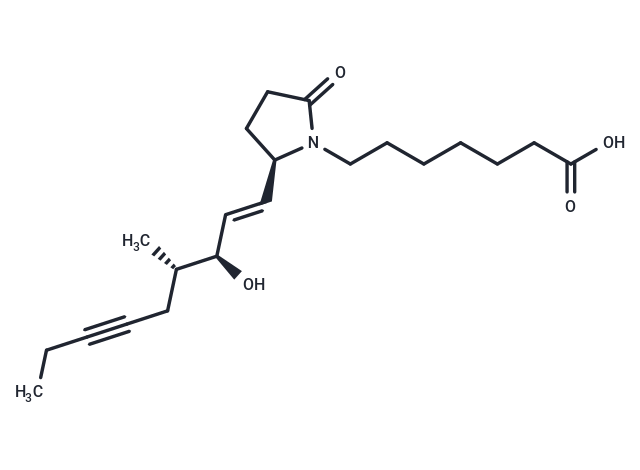- Remove All
 Your shopping cart is currently empty
Your shopping cart is currently empty
KMN-80
The prostaglandin E receptor 4 (EP4) is one of four G protein-coupled receptors that mediate the actions of prostaglandin E2 . Binding of PGE2 to the EP4 receptor causes an increase in intracellular cyclic AMP, which plays important roles in bone formation and resorption, cancer, and atherosclerosis. KMN-80 is a substituted γ-lactam (pyrrolidinone) derivative of PGE1 that acts as a selective and potent agonist of EP4 with an IC50 value of 3 nM (IC50 = 1.4 μM for EP3 and > 10 μM for all other prostanoid receptors). In functional assays it has been shown to stimulate secreted alkaline phosphatase gene reporter activity in EP4-transfected HEK293 cells with an EC50 value of 0.19 nM, demonstrating >5,000 and 50,000-fold selectivity against EP2 and TP, respectively. KMN-80 can induce the differentiation of bone marrow stem cells from both young and aged rats into osteoblasts in vitro (EC50s = 20 and 153 nM, respectively) and exhibits favorable tolerability up to at least 10 μM, whereas the EP4 agonist L-902,688 is highly cytotoxic at similar concentrations in these cells. KMN-80 has been used to repair calvarial defects in an in vivo rat craniomaxillofacial reconstruction model (rate of reduction in defect size equivalent to BMP-2 treated rats) and to promote bone formation in a rat incisor tooth socket model.

KMN-80
| Pack Size | Price | Availability | Quantity |
|---|---|---|---|
| 500 μg | Inquiry | 35 days | |
| 1 mg | Inquiry | 35 days |
Product Introduction
| Description | The prostaglandin E receptor 4 (EP4) is one of four G protein-coupled receptors that mediate the actions of prostaglandin E2 . Binding of PGE2 to the EP4 receptor causes an increase in intracellular cyclic AMP, which plays important roles in bone formation and resorption, cancer, and atherosclerosis. KMN-80 is a substituted γ-lactam (pyrrolidinone) derivative of PGE1 that acts as a selective and potent agonist of EP4 with an IC50 value of 3 nM (IC50 = 1.4 μM for EP3 and > 10 μM for all other prostanoid receptors). In functional assays it has been shown to stimulate secreted alkaline phosphatase gene reporter activity in EP4-transfected HEK293 cells with an EC50 value of 0.19 nM, demonstrating >5,000 and 50,000-fold selectivity against EP2 and TP, respectively. KMN-80 can induce the differentiation of bone marrow stem cells from both young and aged rats into osteoblasts in vitro (EC50s = 20 and 153 nM, respectively) and exhibits favorable tolerability up to at least 10 μM, whereas the EP4 agonist L-902,688 is highly cytotoxic at similar concentrations in these cells. KMN-80 has been used to repair calvarial defects in an in vivo rat craniomaxillofacial reconstruction model (rate of reduction in defect size equivalent to BMP-2 treated rats) and to promote bone formation in a rat incisor tooth socket model. |
| Targets&IC50 | EP3 receptor:1.5 μM (IC50), EP3A receptor (human):880 nM (Ki), EP4 receptor:3 nM (IC50), EP4 (human):2.349 nM (Ki) |
| Molecular Weight | 363.49 |
| Formula | C21H33NO4 |
| Cas No. | 1628759-75-0 |
| Relative Density. | 1.121 g/cm3 (Predicted) |
| Storage | Powder: -20°C for 3 years | In solvent: -80°C for 1 year | Shipping with blue ice. | ||||||||||||||||||||||||||||||
| Solubility Information | DMF: 20 mg/mL (55.02 mM), Sonication is recommended. Ethanol: 25 mg/mL (68.78 mM), Sonication is recommended. Ethanol:PBS(pH 7.2) (1:1): 0.5 mg/mL (1.38 mM), Sonication is recommended. DMSO: 15 mg/mL (41.27 mM), Sonication is recommended. | ||||||||||||||||||||||||||||||
Solution Preparation Table | |||||||||||||||||||||||||||||||
DMSO/DMF/Ethanol
DMF/Ethanol
| |||||||||||||||||||||||||||||||
Calculator
In Vivo Formulation Calculator (Clear solution)
Dose Conversion
Tech Support

Copyright © 2015-2025 TargetMol Chemicals Inc. All Rights Reserved.




